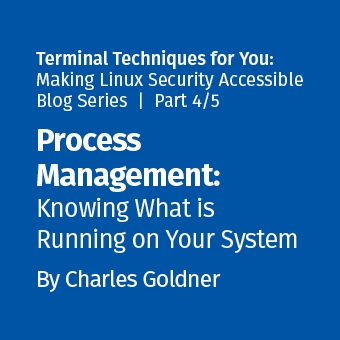Advanced Format Drives (e512)
Advanced format drives are now on the market in full force. These drives are also known as e512 drives. They include the new Long Data Sector standards recommended by International Disk Drive Equipment and Materials Association (IDEMA). These are also known as the 4k - or 4096 - byte sector drives. Fortunately for legacy reasons, the drives are handling the sectors with drive controllers and electronics by emulating 512 byte sectors (hence the term e512). The various OSes and applications out there are going to see sector sizes as 512 bytes. It turns out this is not a major game changer for forensic examiners - unless you're really getting into rebuilding a drive physically.
That said, there is an area of change that should be noted. Some legacy artifacts have changed with the way these drives are now formatted. Specifically, the Master Boot Record (MBR) method of partitioning a drive has changed with Windows 7. Until recently for legacy reasons an MBR occupied 1 sector and reserved 62 additional sectors for a total of 63 sectors - the size of an early hard drive track. That left 62 sectors that a user could have hidden data (I've never heard even anecdotal evidence of this in a real life case).
Following the MBR, as defined in the partition table, the first Volume Boot Record (VBR) has traditionally been located at sector 63. Unfortunately, because of the electronics involved in emulating 512 byte sectors, this is not efficient in e512 drives. Consider that 4096 byte sectors will emulate 8 512 byte sectors (512*8=4096). Sector 63 does not fall on a multiple of 8 - in fact it's one 512 byte sector shy of a multiple of 8. Windows XP and earlier machines create volumes based on the 63 sector track size and this overlap can cause performance issues for e512 drives since they are reading the entire 4k sector at a time. So two items crop up as "gotcha" issues that an examiner needs to be aware of.
1) Windows XP and Earlier MBR
To use e512 disks, hard disk manufacturers have enabled a new jumper. In Western Digital drives, there is a jumper than can be set from pins 7-8 that adds a virtual sector offset to partitioning schemes (hence sector 63 becomes sector 64) through the drive's electronics. That places the VBR in a place the OS and applications can look for at an area where it is efficient for the drive controller to read/write. More testing needs to be conducted in this realm to determine what effect (if any) it will have on forensic examinations.
2) Windows 7 Formats
To compensate for the sector sizes, Windows 7 and Vista are creating MBR partitioning schemes on e512 drives where the first partition will always start on a multiple of 4k sectors. The location of the VBR for the first partition is defined in the MBR partition table as has been done historically - it's just that the location of the first partition is now dynamic instead of fixed to sector 63.
To demonstrate, I'll compare three drives. One was formatted previously to exFAT at 1 GB, one has was formatted to FAT32 at 6 GB, and another was formatted to NTFS at 500 GB. I used Windows 7 Enterprise to perform this test. I did the same test on my laptop which runs Vista SP2 and had an e512 WD drive connected with a USB enclosure with the same results.
The partition tables populate as normal. The only difference is that the location of the first partition is not at sector offset 63.
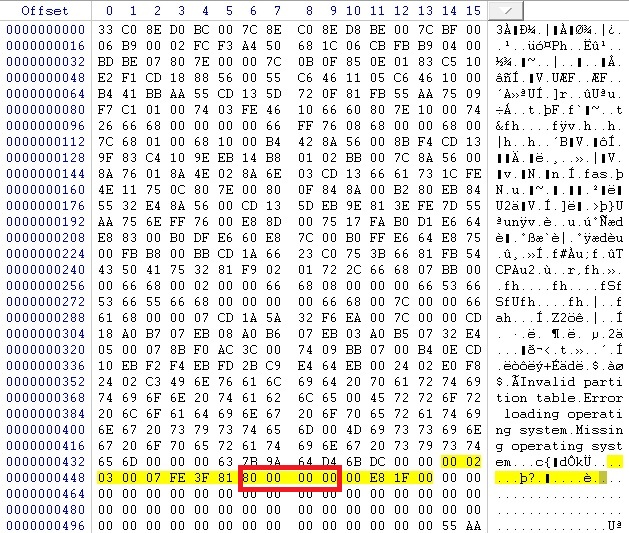
An exFAT formatted volume shows the starting sector of the sole partition at sector offset 128 (0x80 00 00 00).
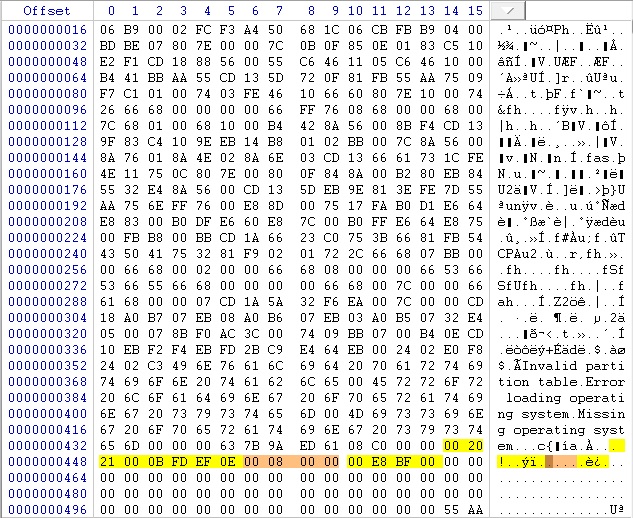
A FAT formatted volume shows the starting sector of the sole partition at sector offset 2048 (0x00 08 00 00).
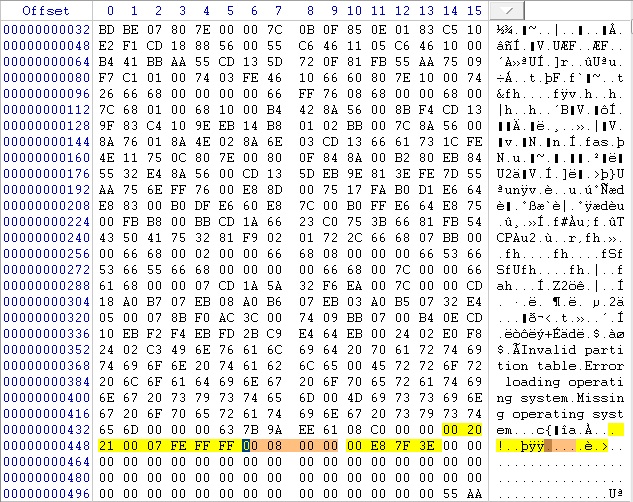
An NTFS formatted volume shows the starting sector of the sole partition at sector offset 2048 (0x00 08 00 00).
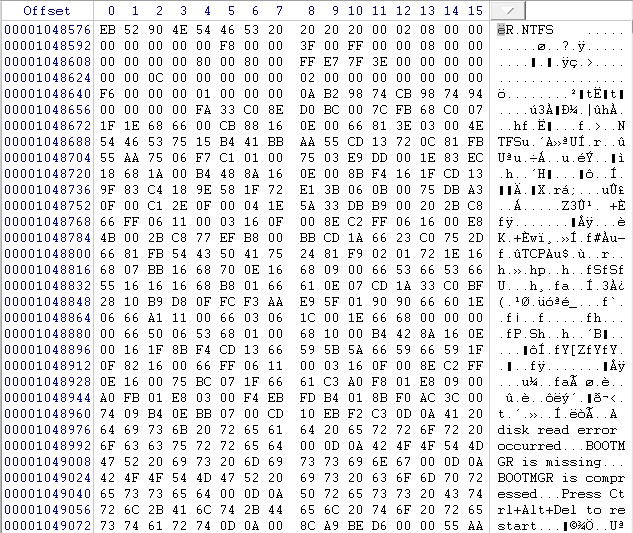
Indeed the first sector of the partition, sector 2048, of the individual volumes contains the VBR for the respective volume type.
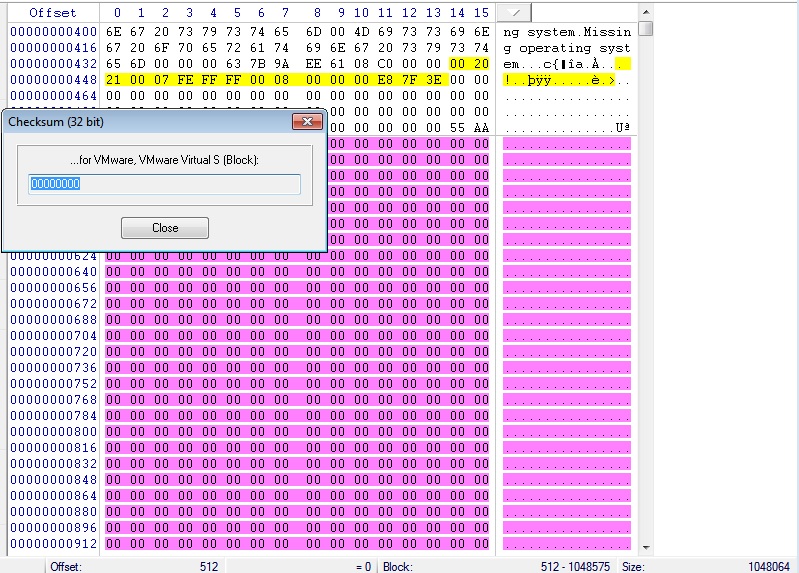
Sure enough, a CRC sum of the data between the first sector and sector 2048 indicates a sum of 0x00.
Conclusions
Don't take it for granted that the first sector of a volume will reside at sector 63. This is no longer an absolute. As is shown by the CRC (and manual check) of the data between the MBR and the first partition there can be plenty of free space to hide data.
A more realistic "gotcha" though could be taking for granted that the first volume should be at sector 63. When an examiner sees the first partition starting at sector 2048, he/she should not immediately assume there is a lost 1MB partition. It could just be a function of an Advanced Format Drive.
Advanced Format and Long Sector Drive General Information:
- http://en.wikipedia.org/wiki/Advanced_Format
- http://www.wdc.com/wdproducts/library/WhitePapers/ENG/2579-771430.pdf
- http://www.wdc.com/en/products/advancedformat/
- http://www.bit-tech.net/hardware/storage/2010/04/01/the-facts-4k-advanced-format-hard-disks/1
Jeff Hamm is a Senior Forensic Computer Analyst for Paradigm Solutions and was formerly a Sergeant with the Oakland County Sheriff's Office in Michigan. He is now a full time contractor for a federal digital forensic laboratory where he carries a case load and manages a forensic team including cell phone and media analysts. He has been working media forensics and conducting computer crime investigations since 2001 and he holds the CFCE, EnCE, and ACE.




